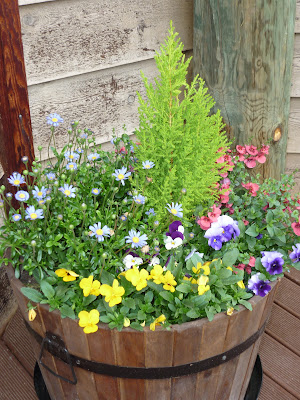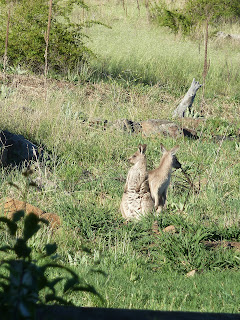An easy bread recipe to start with. It's simple and can be made without too much effort every few days and to get practice before moving on to other types of breads.
Ingredients:
1 kg of white flour (or 750 gr of plain white flour and 250 gr of wholemeal flour)
20 gr salt (or 10 gr if you want less salt - experiment with the dose to find the best taste for you)
10 gr dry instant yeast
600 gr warm water (not hot - just lukewarm - should feel warm to the touch - about body temperature)
How to make the bread:
1. Mix the ingredients
1. In a large bowl put in the flour, the salt and the yeast. Mix until combined.
2. Slowly pour in the lukewarm water and mix.
3. Keep mixing until it becomes a dough. It should be a bit gooey at first but the more it is worked the easy it is to manage. It should resemble play-dough.
This can be done by hand or by machine. I found mixing it by hand works better. In a machine, I often have to stop and scrape some of the mixture off the sides or push the flour down to absorb the water.
I've been using normal plain white four which I bought in bulk at CostCo and it still turns out okay. However, for a better tasting loaf and more structure it is best to use a strong flour such as baker's flour. I will do some research on local flours available and see how they perform.
2. Knead the dough
1. Lightly flour a bench top - you only need a little space about the size of a dinner plate.
2. Knead the dough for approximately 15 minutes for maximum effect. Push the palms of your hands deeply into the ball of dough, flatten it, roll it, stretch it, bash it, punch it, throw it on the bench - whatever takes your fancy. Get plenty of air into it!
3. The dough should now feel soft, smooth and warm to the touch.
This is the best bit - truly, it is. Sometimes I pretend it's a mini gym workout for my arms, other times I use it to get frustration or anger out of my system, other times I find kneading relaxing - I let my mind wander and forget what I'm doing, I lose track of time and use it to escape reality , other times I find it quite sensual - the warm soft dough, the smell of yeast, the ritualistic rocking motion of the kneading, the image of hot bread out of the oven, the smell and the unique taste gives me pleasure.
3. Let the dough rest - First time
1. Put the dough back in the same bowl you mixed it in.
2. Cover the dough with very lightly oiled plastic wrap. (to stop air getting to it and forming a thin crust over the dough)
3. Cover with a clean tea towel.
4. Place in a warm spot in the kitchen (near a window with a bit of sunshine or near the stove -it really doesn't matter if it's not too warm, it'll only take a while longer). Also, make sure there is no draught (no open windows or cross breezes near the dough - it's quite sensitive)
5. Leave to rest for approximately 2-3 hours. (2 hours is quite sufficient. I like to leave mine a little longer).
6. Go and do something else now. Don't watch it rise for the next 3 hours like I did the first time!
4. Knead the dough again
1. Remove the covers.
2. Punch the dough in the middle hard! It should deflate instantly.
3. Remove the dough from the bowl or you can leave it in the bowl and knead it in there.
4. Knead the dough for a couple of minutes. A quick knead suffices. Pull the dough outwards stretching it as you go and then pull the dough back over onto itself. A motion of out, over and in. I like to think of it as a square - pulling the corners back into the middle. I do this a few times.
5. Shape the dough.
A cob usually works well as also does a free standing rustic loaf (no tin) - you can let your imagination run wild. Make sure you tuck in the dough underneath (give the dough a few strokes down the sides and tuck in underneath)
5. Rest - Second time
1. Cover the dough with very lightly oiled cling film (the same used before) and cover with a tea towel (same one as before)
2. Place on a towel or tray or blanket covered with lightly floured baking paper. (this comes in handy later when you need to transfer the bread to the oven)
3. Leave in warm, draught free place to rest approximately 45 minutes.
4. Wipe any crumbs from the bottom of the oven with a tea towel. Pre-heat the oven to 220'C.
5. Go and do something else.
6. Put the bread in the oven
1. Uncover the bread.
2. With a sharp bread knife, make 3 large and deep incisions diagonally on top of the bread. You can also make another 3 incisions in the other direction to form a criss-cross pattern.
3. Optional - Put a topping on the bread if you want - mix a teaspoon of salt with a couple of tablespoons of water. Brush the top of the bread with the mixture. The top should then appear sticky and wet. Top with poppy seeds, rolled oats, sesame seeds, etc or leave as is - the salt and water mixture will make the crust thicker and crispier.
4. Slide the bread with the aid of the baking paper straight into the bottom of the oven.
5. Bake for 25 minutes.
6. Reduce heat to 200'C.
7. Bake a further 20-25 minutes.
8. Take out of oven. Tap bread. Should sound hollow.
9. Allow to cool.
Enjoy!
I was initially put off baking my own bread simply because I though it was too difficult and time consuming. To me, the idea of kneading the bread and waiting hours for it to rise was a waste of precious time and effort when I could drive to the shop and buy a perfect loaf in a matter of minutes or while out shopping.
Now, after having made the effort to make my own bread, I must say, that yes it was hard at first - the kitchen was a mess, flour everywhere, my hair had dough in it, and the bread wasn't always what I wanted it to be. I really wondered why I was bothering. With perseverance, I got better at it - I don't make any mess in the kitchen, I know the amount of ingredients off by heart which makes things quicker, I don't stand around watching and worrying the bread won't rise and I've learnt that bread will never be successful if I use the packet of old yeast I had in the cupboard since last year and thought it was a good idea to use up.
I never expected that having home made bread, the most basic and simplest of things in life, can bring such satisfaction - in the taking on the challenge, in the accomplishment of the task and the enjoyment of a house filled with beautiful baking smells whilst savouring the warm tasty bread lovingly made with healthy ingredients.
Instructions - Cheat Sheet
1. Mix ingredients in a bowl until a dough forms.
2. Knead dough vigorously for approx 15 mins.
3. Place back in bowl and cover with lightly oiled cling film and tea towel.
4. Leave to rise for approx 2-3 hours.
5. Punch in middle to deflate.
6. Knead lightly for a few minutes.
7. Shape bread.
8. Place on tray or tea towel covered with floured baking paper
9. Cover dough with oiled cling film and tea towel.
10. Leave to rise for approx 45 mins.
12. Pre-heat oven to 220'C.
13. Slash top of bread with sharp bread knife.
14. Optional: Top bread with water-salt solution and sprinkle with perferred topping (grains, seeds etc.)
15. Slide the bread into the bottom of the oven.
16. Bake for 25 mins.
17. Lower temperature to 200'C.
18. Bake a further 20-25 mins.
19. Take bread out and tap. Shoould sound hollow.
20. Place on a rack to cool.
































